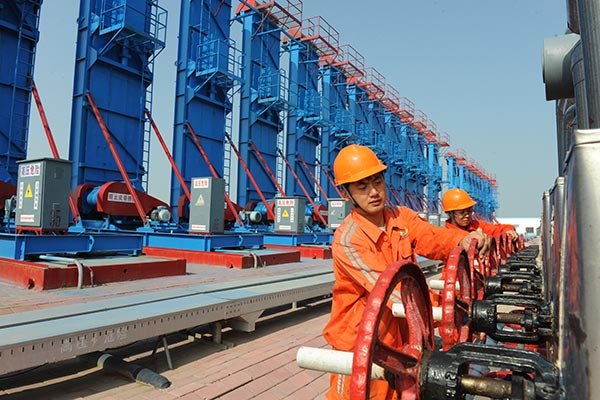Sinopec to close four oilfields in Shandong
By Lyu Chang (China Daily) Updated: 2016-02-18 06:57
 |
|
Workers check facilities at the Shengli Oilfield near Dongying, Shandong province. The oil producer is to shut down four oilfields to reduce costs amid plummeting oil prices. [HU QINGMING / FOR CHINA DAILY] |
China's second-largest oil major will shut down four oilfields in the country's eastern Shandong province to stay afloat amid plummeting oil prices.
China Petroleum & Chemical Corp, also known as Sinopec, will close the four oilfields in the Shengli oilfield, the nation's second-largest oilfield, later this year, company sources said. It will be the first shutdown after the first barrel of oil was pumped from the Shengli oilfield more than five decades ago.
The four oilfields are the least profitable projects in the area, sources said.
The closures signify a dramatic fall for the company. The Shengli oilfield, once one of the most profitable oil companies in China, reported about 9.2 billion yuan ($1.4 billion) in losses last year as global oil prices have fallen sharply over the past year.
Since June, global oil prices have fallen by more than half, with Brent crude oil currently below $30 a barrel for the first time since May 2009.
Experts said the sharp fall in global oil prices have led to revenue shortfalls for many energy majors in the world.
The Daqing oilfield, the largest oilfield explored by China's major oil and gas producer China National Petroleum Corp, reduced crude oil production in 2015 for the first time in seven years.
It produced about 38.4 million metric tons of oil last year, about 1.5 million tons lower than in 2014. Located in Northeast China's Heilongjiang province, the oilfield will further cut its production to 32 million tons by 2020.
According to official data, the average cost of oil production in China is roughly $40 a barrel. Experts said many oil producers failed to reach a profit when oil prices dropped under $30 a barrel.
"Many oil producers are facing the same kind of problem when crude prices fall," said Gao Jian, a crude oil analyst at Shandong-based consultant SCI International.
"It is normally the last straw when oil producers shut down oilfields because after the shutdown, if they wanted to reopen them, they could stand to lose millions of dollars per day," he said.
He said more rigs could begin to see a fall in production this year.
- Money laundering claim sends ICBC directors to Spain
- Chinese banks play major presence in Dubai intl financial center: Official
- China January consumer prices up 1.8%
- China producer prices down 5.3% in Jan
- Aston Martin to develop electric car with China's LeEco
- Aviation giants confident in Chinese market's growth potential
- TCM makers welcome state support
- G20 trade ministers to meet in Shanghai in July
















